Council Tax Reduction in Scotland, 2014-15
This publication provides statistics on the Council Tax Reduction scheme, which reduces the Council Tax liability of vulnerable people in Scotland. The statistics are based on data extracts and statistical returns from local authorities. Statistics are available for each month between April 2013 and March 2015.
This document is part of a collection
Statistical summary
Caseload by Local Authority
In March 2015, there were 525,640 Council Tax Reduction recipients. The five local authorities with the highest caseload in March 2015 were Glasgow City (18.5 per cent of all recipients in Scotland), North Lanarkshire (7.7 per cent), Edinburgh (7.3 per cent), Fife (6.4 per cent) and South Lanarkshire (6.4 per cent). Together, they accounted for almost half (46.2 per cent) of the CTR caseload for Scotland. The three island Local Authorities had the smallest share of caseload – Shetland Islands (0.2 per cent), Orkney Islands (0.2 per cent) and Eilean Siar (0.5 per cent). Figure 2 shows the CTR caseload in a treemap, which allows a visual comparison of the caseload for each Local Authority. Numbers of CTR recipients as a proportion of dwellings are shown in the section titled ‘Chargeable dwellings and Council Tax Bands’, on page 20.
Figure 2: Treemap of Council Tax Reduction caseload by Local Authority: March 2015
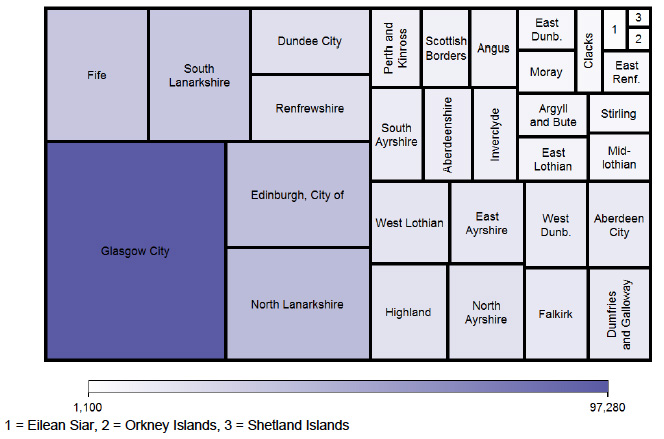
1 = Eilean Siar, 2 = Orkney Islands, 3 = Shetland Islands
Caseload trends
The number of households receiving CTR in Scotland fell from 552,380 in April 2013 to 525,640 in March 2015, a decrease of nearly 27,000 (-4.8 per cent). Figure 3 below shows the downward trend in the number of recipients over this period.
Figure 3: Council Tax Reduction caseload, Scotland, April 2013 to March 2015
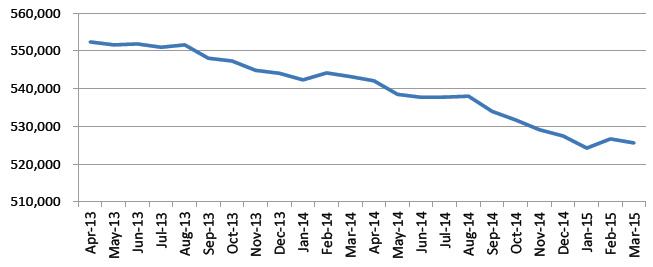
Figure 4 shows the percentage change between April 2013 and March 2015 for all Local Authorities. All Local Authorities in Scotland have seen a decrease in CTR caseload since the scheme was introduced (i.e., between April 2013 and March 2015). However there were variations in the size of decrease.
The largest percentage decreases in caseload numbers were seen in Shetland Islands (-11.6 per cent), Aberdeen City (-10.8 per cent), Eilean Siar (-10.1 per cent) and Moray (-9.1 per cent). It should be noted that, while Shetland Islands and Eilean Siar had relatively large percentage decreases in caseload, these equate to relatively small numbers of recipients.
The smallest decreases were seen in Clackmannanshire (-2.1 per cent), East Lothian (-2.2 per cent), Orkney Islands (-2.9 per cent) and North Ayrshire (-3.0 per cent). The caseloads for each Local Authority for each month between April 2014 and March 2015 are shown in Table 1.
Figure 4: Percentage decrease in Council Tax Reduction caseload between April 2013 and March 2015 by Local Authority
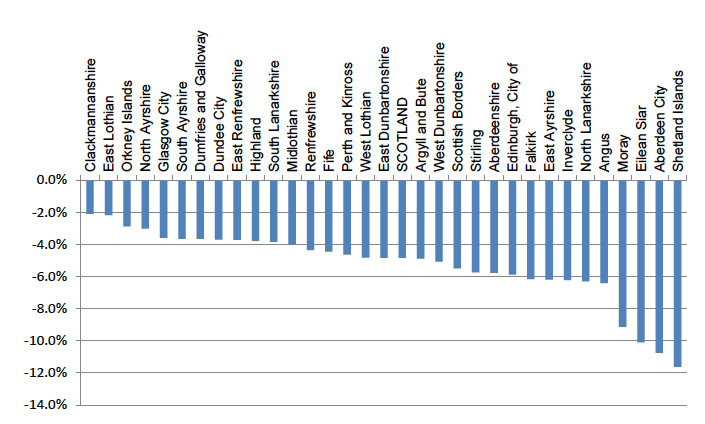
Table 1: Council Tax Reduction recipients by Local Authority: April 2014 to March 2015
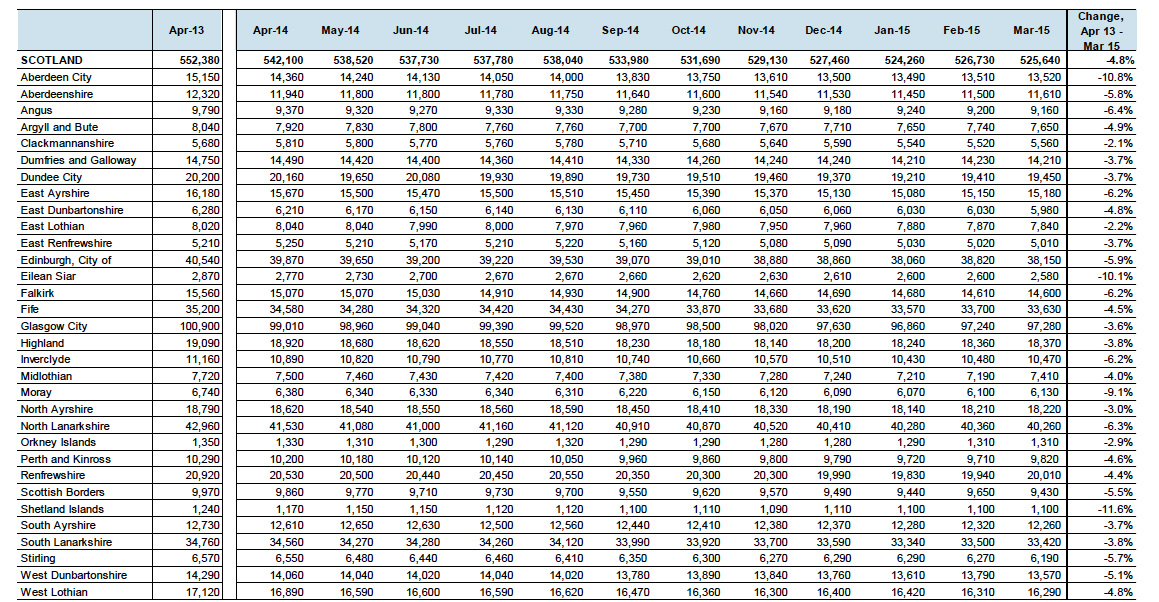
1. Recipients are as at monthly count date (see Background notes, page 25).
2. Figures are rounded to the nearest 10. Components may not sum to total due to rounding.
3. Figures for each month from April 2013 to the most recent dataset available can be found here: http://www.gov.scot/Topics/Statistics/Browse/Local-Government-Finance/CTR/LAtables
Reductions in Council Tax income
When a Local Authority reduces a person’s Council Tax liability under the CTR scheme, it reduces the amount of Council Tax income it would otherwise be able to collect. Any reduction in Council Tax income therefore represents a reduction in the funding available to Local Authorities for providing services[1]. The CTR scheme, like its predecessor (Council Tax Benefit), therefore represents a cost which is publicly funded.
Information on the total value of all reductions under the CTR scheme is collected via two Scottish Government data collections:
1. The Council Tax and Community Charge Receipts Return (CTRR) is issued before a Local Authority’s accounts are audited and therefore collects provisional unaudited values.
2. Local Financial Returns are issued after a Local Authority’s accounts are audited, therefore collect final audited values.
Table 2 shows the total value of reductions for 2013-14 and 2014-15. In 2014-15, based on provisional unaudited values, the CTR scheme reduced Council Tax income by a total of £345.9 million. In 2013-14, the total based on final audited returns was £359.7 million. These figures represent a decrease of 3.8 per cent in the total value of all reductions between 2013-14 and 2014-15. This is in line with the aforementioned decrease in caseload.
As with caseload, all of the 32 Local Authorities have seen a decrease in total reductions through CTR between 2013-14 and 2014-15. The largest percentage decreases were seen in Shetland Islands (-7.7 per cent), Eilean Siar (-7.0 per cent), and Aberdeen City (-6.7 per cent). The smallest percentage decreases were seen in Orkney Islands (-2.7 per cent), Midlothian (-2.6 per cent) and East Renfrewshire (-2.1 per cent).
Table 2: Total reductions in Council Tax income through Council Tax Reduction scheme for 2013-14 and 2014-15 by Local Authority (£ millions)
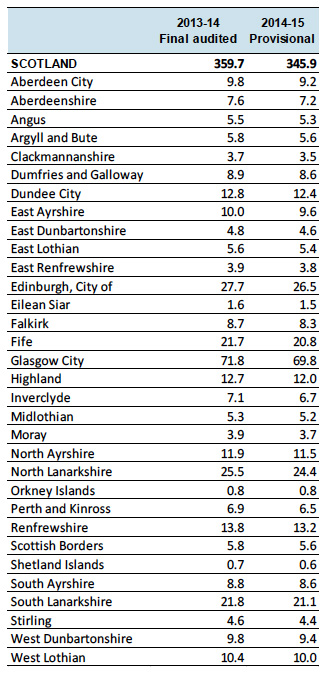
1. Provisional figures are derived from information supplied by local authorities to Scottish Government on the statistical return Council Tax and Community Charge Receipts (CTRR).
2. Final audited figures on CTR for 2013-14 were first published in Scottish Local Government Financial Statistics, 2013-14, available here: http://www.gov.scot/Publications/2015/02/3131
Weekly awards
The total estimate of CTR weekly awards has decreased from £7.1 million in April 2013 to £6.7 million in March 2015. Table 3 shows the total weekly award estimates for each month from April 2014 to March 2015. CTR award totals have followed the same general pattern as caseload, and all Local Authorities have seen a decrease in their weekly award totals since April 2013.
Caseload and total weekly awards are closely linked, with most of the change in total weekly awards being driven by changes in caseload. Figure 5 shows the percentage changes in caseload and total weekly awards from the previous month (e.g. between April 2013 and May 2013, caseload decreased by 0.1 per cent, while total weekly awards decreased by just over 0.2 per cent). The graph shows that caseload and total weekly awards followed each other closely, between April 2013 and March 2015. Other factors that can affect the value of awards include Council Tax charges, age structure of the population and household income.
Figure 5 also shows small peaks in caseload and total weekly awards around March each year, indicating a possible seasonality effect.
Figure 5: Council Tax Reduction percentage changes since previous month for caseload and total weekly awards
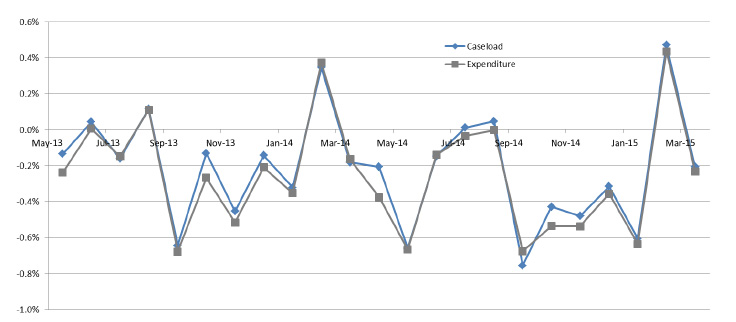
1. Figures derived from Table 1 and Table 3
Table 3: Council Tax Reduction total weekly award estimate (£000’s) by Local Authority: April 2014 to March 2015
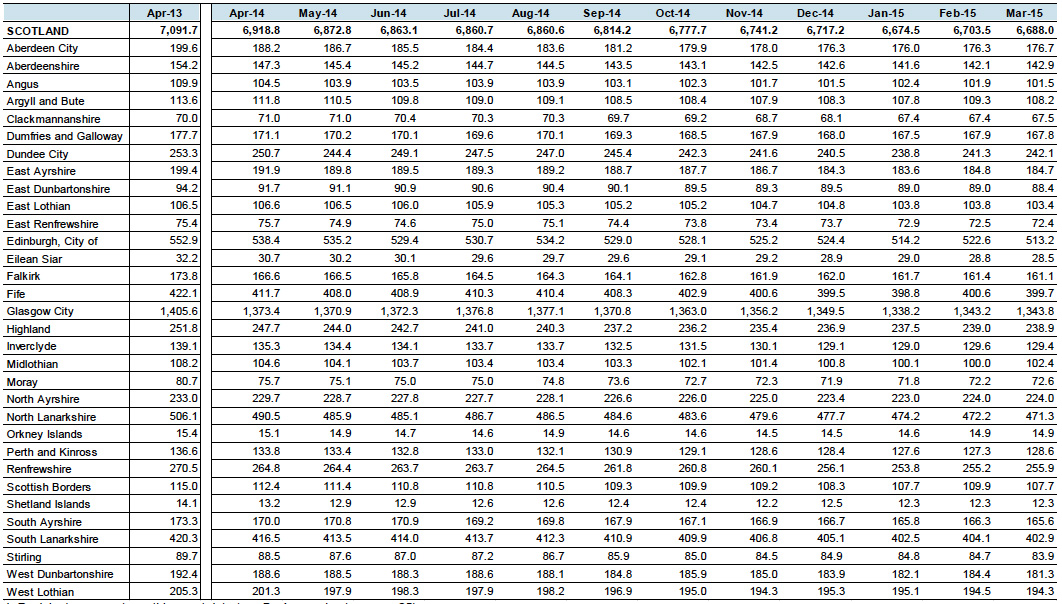
1. Recipients are as at monthly count date (see Background notes, page 25).
2. Figures are rounded to the nearest £100. Components may not sum to total due to rounding.
3. Weekly award estimate was based on 'caseload multiplied by average weekly award' for each local authority and benefit type for the given month. See Background notes, page 25.
4. Figures for each month from April 2013 to the most recent dataset available can be found here: http://www.gov.scot/Topics/Statistics/Browse/Local-Government-Finance/CTR/LAtables
Caseload by passported status
Figure 6 illustrates CTR caseload, split by benefit types for the ‘passported’ recipients, and employment status. In March 2015, ‘passported’ recipients accounted for almost 70 per cent of CTR recipients. The most common ‘passporting’ benefits were Income-related Employment and Support Allowance and Pension Credit (Guarantee Credit). Each of these benefits made up around a quarter of all CTR recipients. CTR recipients who were in receipt of Income Support or Income-based Jobseeker’s Allowance each accounted for around a tenth of all CTR cases. The majority of non-passported recipients were not in employment.
Figure 6: Council Tax Reduction caseload by ‘passported’ status, benefit type and employment status: March 2015
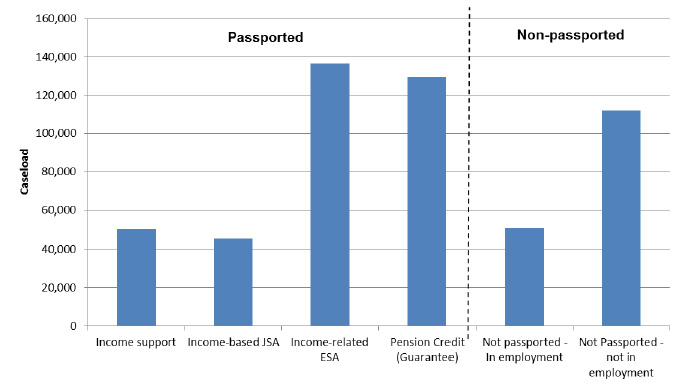
Figures derived from Table 4
The number of recipients by ‘passported’ status, local authority, benefit type and employment status is shown in Table 4. Some key variations across Local Authorities are:
- The Local Authorities with the highest percentages of CTR recipients that were passported were Glasgow (74.1 per cent), North Ayrshire (72.0 per cent) and North Lanarkshire (71.5 per cent).
- The Local Authorities with the lowest percentages of passported recipients were Midlothian (61.5 per cent), East Lothian (62.4 per cent) and Aberdeenshire (62.6 per cent).
- The highest percentage of recipients on Pension Credit was seen in Eilean Siar, at 44.2 per cent.
- The percentage of recipients in employment was highest in Edinburgh (14.2 per cent), East Renfrewshire (13.4 per cent), and East Lothian (12.5 per cent).
Table 4: Council Tax Reduction recipients by ‘passported’ status, benefit type, employment status and Local Authority: March 2015
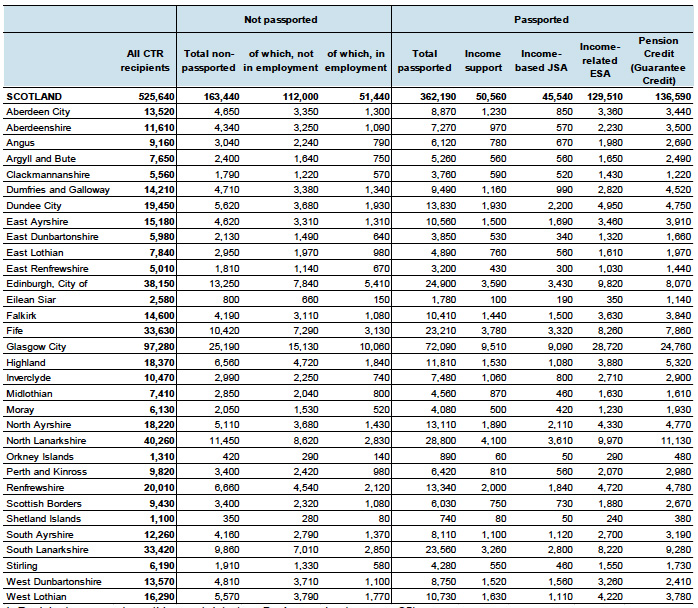
1. Recipients are as at monthly count date (see Background notes, page 25).
2. Figures are rounded to the nearest 10. Components may not sum to total due to rounding
Table 5 below shows the CTR caseload between February 2014 and March 2015, by benefit type and employment status. The figures show that the number of CTR recipients in employment has steadily increased, while the number not in employment has decreased. This is consistent with the theory that the decrease in caseload could be related to a decrease in unemployment over this time period.
There has been a net increase in the number of CTR recipients who also receive Income-related Employment and Support Allowance, accompanied by a decrease in the number receiving Income-based Job Seeker’s Allowance. This is consistent with caseload statistics published by the Department for Work and Pensions, which show a decrease in Jobseekers and an increase in the number of ESA recipients.[2]
Table 5: Council Tax Reduction recipients by ‘passported’ status, benefit type, employment status and Local Authority: April 2014 to March 2015

1. Recipients are as at monthly count date (see Background notes, page 25).
2. Figures are rounded to the nearest 10. Components may not sum to total due to rounding.
3. Figures for previous months are not available because of a technical issue with some early datasets which meant that it was not possible to produce this breakdown
Weekly awards by passported status
Table 6 shows the average weekly awards for each Local Authority, benefit type and employment status. The average award per recipient was £12.74 per week in March 2015. Average weekly awards varied both by Local Authority and by passported/non-passported status. Non-passported recipients who were in employment received the least, at £10.08, compared to those on Pension Credit (Guarantee), who received the most, at £13.93 per week on average. Passported awards will generally be higher since, by virtue of their income, these recipients have their Council Tax liability reduced in full.
The Local Authority with the highest average weekly award was East Dunbartonshire with £14.79 per week, and the lowest was Falkirk with £11.05. These differences are likely to have been due to a number of factors which are known to vary across Local Authorities; for example differences in Council Tax charges, age structure of the population, and household composition and income.
Table 6: Council Tax Reduction recipients average weekly award by ‘passported’ status, benefit type, employment status and Local Authority: March 2015
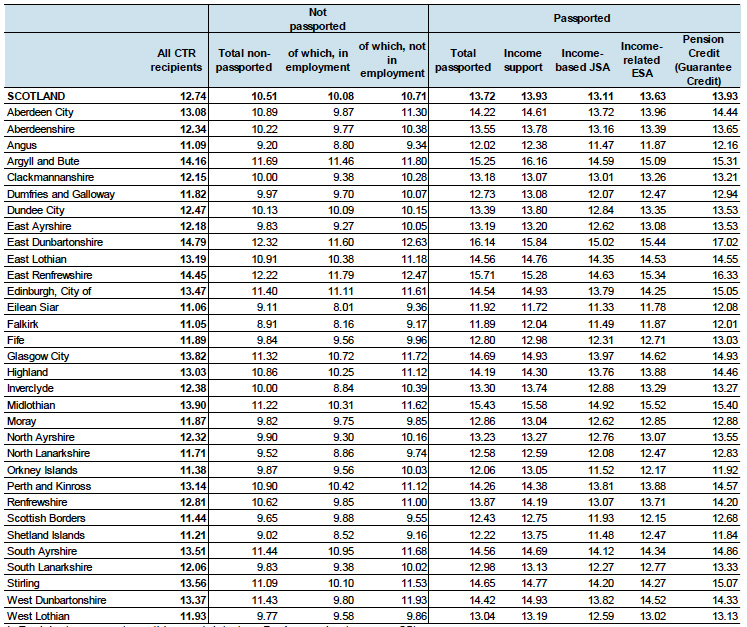
1. Recipients are as at monthly count date (see Background notes, page 25).
2. Average awards are shown as pounds per week and rounded to the nearest penny.
Full CTR and partial awards
Full CTR refers to recipients whose Council Tax liability is reduced to zero - in practice, this means that such recipients will not be asked to pay any Council Tax. Partial CTR refers to recipients whose Council Tax liability is reduced, but they are still liable for an amount. CTR recipients who are in reciept of a passporting benefit will automatically receive full CTR. Recipients who do not receive a passporting benefit can receive full CTR, or an award that covers part of their Council Tax liability (see ‘How awards are calculated’, page 4 for more information on this).
Figure 7 and Table 7 show that a total of 413,520 recipients were in receipt of full CTR in March 2015. This is 78.7 per cent of all CTR recipients. Of these, 362,190 received full CTR as a result of a passporting benefit. A further 51,330 were not in receipt of a passporting benefit, but their income was deemed low enough to receive full CTR. The remainder received a CTR award that covered part of their Council Tax liability, according to their financial circumstances.
Figure 7: Council Tax Reduction recipients by full or partial award: March 2015
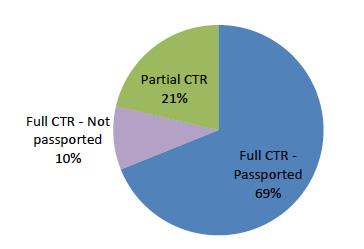
Table 7: Council Tax Reduction recipients by full or partial award: March 2015

1. Recipients are as at monthly count date (see Background notes, page 25).
Percentage of dwellings in receipt of CTR
1 in 5 chargeable dwellings in Scotland were entitled to a reduction in their Council Tax liability through CTR in March 2015. There were variations across Local Authorities, reflecting differences in the age structure of the population and household incomes. The highest percentages were seen in Glasgow City (35.2 per cent), West Dunbartonshire (31.1 per cent) and in Dundee City (29.3 per cent). This compares to 10.4 per cent each in Shetland Islands and Aberdeenshire. The map in Figure 8 illustrates the percentage of dwellings in receipt of CTR support in each Local Authority in Scotland, and the percentages for each Local Authority are shown in Table 8.
The total gross Council Tax billed in 2014-15, before CTR, was £2.42 billion across Scotland. This means that total reductions through CTR accounted for 14.3 per cent of total Council Tax billing. This is much lower than the 21.7 per cent of bills to dwellings which featured CTR due to two main factors. Firstly, not all CTR awards are for the full amount of the Council Tax liability i.e. some non-passported recipients will, due to their level of income, only receive CTR covering a proportion of their liability. Secondly, as described in the next section of this report, the distribution of CTR recipients is heavily skewed towards the lower Council Tax bands where annual liability is relatively low and, hence, CTR awards are lower.
Figure 8: Percentage of chargeable dwellings receiving Council Tax Reduction, by Local Authority: March 2015
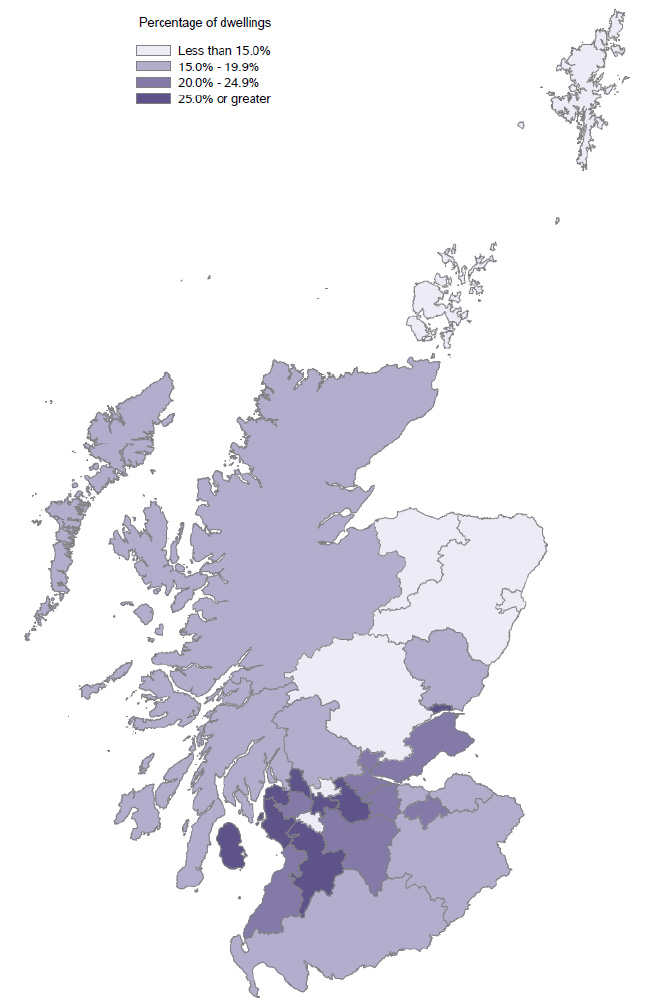
Figures derived from Table 8
Chargeable dwellings and Council Tax Bands
Each chargeable dwelling in Scotland is placed in a Council Tax band between A and H, depending on the market value of the dwelling as at 1st April 1991. Band A dwellings are liable for the lowest rates of Council Tax and Band H attract the highest rates.
The number of CTR recipients by Council Tax Band is shown in Table 8. There are more recipients at the lower bands, with 216,150 in Band A and 22,700 in Band E or above. However, when looking at these figures, it is necessary to consider the spread of dwellings across Council Tax bands - around three-quarters of all chargeable dwellings are in the lower valued four bands (bands A to D), and a quarter are placed in the higher four bands (E and above).
Figure 9 breaks down the number of dwellings in each Council Tax band by those that are receiving CTR, and those are not. The broad pattern is that the CTR group includes a greater proportion of households at lower Council Tax bands, than Scotland as a whole. The highest number of CTR recipients is seen in Band A, where 42.3 per cent of dwellings are in receipt of CTR. At Band B, the total number of chargeable dwellings is higher than Band A, but the number receiving CTR is lower. The number of CTR recipients continues to decrease through the Council Tax bands to very low numbers, equating to 3.6 per cent of dwellings in Band E or above.
Figure 9: Chargeable dwellings by Council Tax Reduction receipt: March 2015
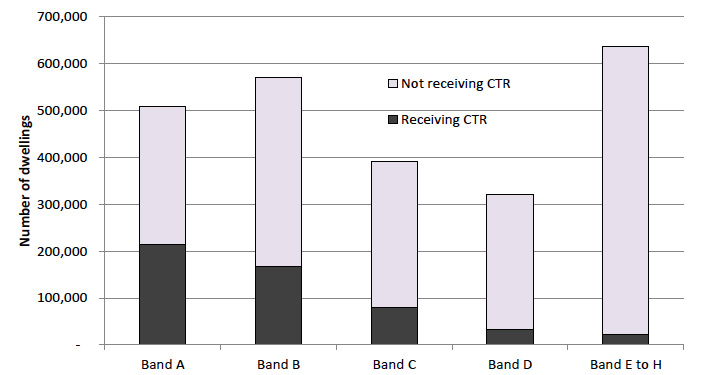
1. Figures for chargeable dwellings are as reported by local authorities on statistical return CTAXBASE 2014.
Table 8: Council Tax Reduction recipients by Local Authority and Council Tax band: March 2015
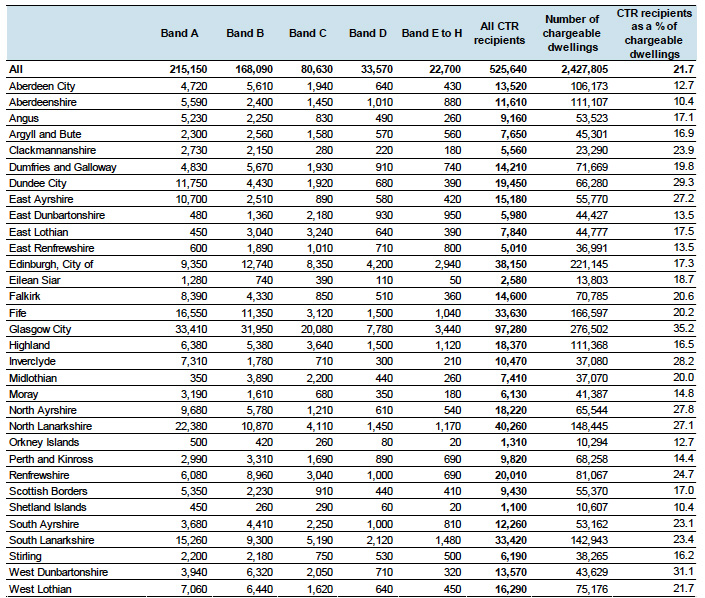
1. Recipients are as at monthly count date (see Background notes, page 25).
2. Components may not sum to total due to (i) rounding (ii) exclusion of claimants with unknown Council Tax band.
3. Figures for chargeable dwellings are as reported by local authorities on statistical return CTAXBASE 2014.
Deprivation
Table 9 and Figure 10 show the spread of CTR recipients across areas of deprivation, according to the Scottish Index of Multiple Deprivation (SIMD). Under this approach, each property is placed within one of 6,500 datazones covering Scotland. Each datazone has a calculated ‘deprivation score’ and these scores are then used to rank the datazones. Decile 1 contains the 10 per cent most deprived datazones, Decile 2 the next most deprived, and so on.
CTR recipients were heavily concentrated in areas of highest deprivation, with over 55 per cent of recipients in March 2015 in the lowest 3 deciles i.e. the 30 per cent most deprived datazones. Around 9 per cent of CTR recipients were in the highest 3 deciles i.e. the 30 per cent least deprived datazones.
It should be noted that datazones have a population of around 750 on average, and that there may be variation in deprivation levels within datazones. Moreover, the overall SIMD score assesses deprivation across 7 domains - income, employment, health, education, housing, geographic access to services, and crime. The CTR scheme is of course principally concerned with income, as a basis for making awards.
Table 9: Council Tax Reduction recipients by Scottish Index of Multiple Deprivation Decile: March 2015
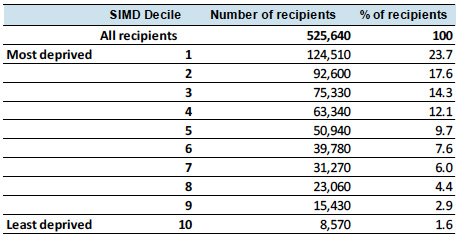
1. Recipients are as at monthly count date (see Background notes, page 25).
2. Components may not sum to total due to (i) rounding (ii) exclusion of claimants with unknown SIMD.
Figure 10: Council Tax Reduction recipients by Scottish Index of Multiple Deprivation Decile: March 2015
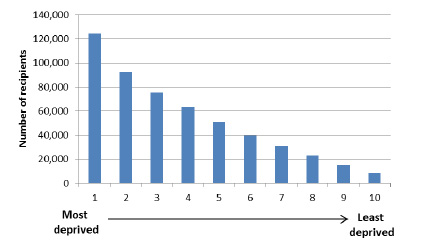
Age, gender and family type
Table 10, Figure 11 and Figure 12 show the number of CTR recipients by age band and family type and Table 11 shows the average CTR weekly award for each group, for March 2015. The age breakdown shows that 200,950 (38.2 per cent of) CTR recipients were aged 65 or over in March 2015. The 60-64 age band had the highest average weekly award at £13.42 and the under 25 age category had the lowest average weekly award, at £11.78.
The figures by family type show that the majority of recipients (64.6 per cent) were single with no child dependent; this group were awarded an average of £12.07 per week in CTR which was lower than any other family type. Lone parents (i.e. single with child dependents) made up 16.5 per cent of CTR recipients and they received an average weekly award of £12.27. A fifth of CTR recipients were in couples. Couples with child dependents had an average weekly award of £16.06, which was higher than any other family type.
Table 10: Council Tax Reduction recipients by Age Group and Family Type: March 2015
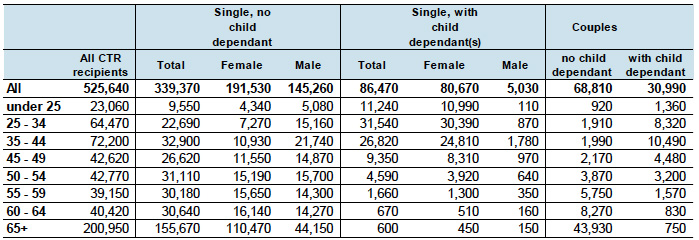
1. Recipients are as at monthly count date (see Background notes, page 25) of either:
(a) the recipient if they are single, or
(b) the elder of the recipient or partner if claiming as a couple.
2. Components may not sum to total due to (i) rounding (ii) exclusion of claimants with unknown age or gender.
Table 11: Council Tax Reduction recipients average weekly award by Age Group and Family Type: March 2015
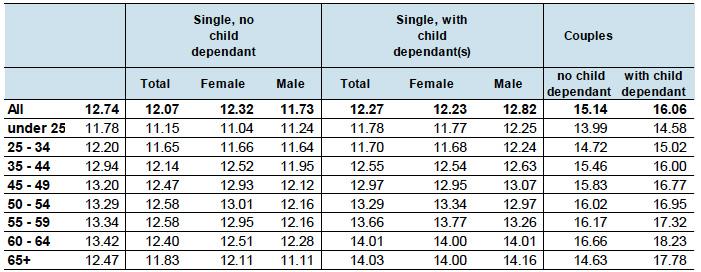
1. Recipients are as at monthly count date (see Background notes, page 25) of either:
(a) the recipient if they are single, or
(b) the elder age of the recipient or partner if claiming as a couple.
2. Average awards are shown as pounds per week and rounded to the nearest penny.
Figure 11: Council Tax Reduction recipients by Age Group: March 2015
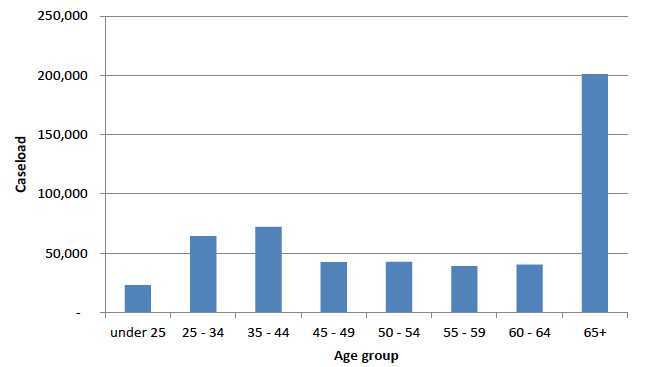
1. Recipients are as at monthly count date (see Background notes, page 25) of either:
(a) the recipient if they are single, or
(b) the elder of the recipient or partner if claiming as a couple
Figure 12: Council Tax Reduction recipients by Family Type: March 2015
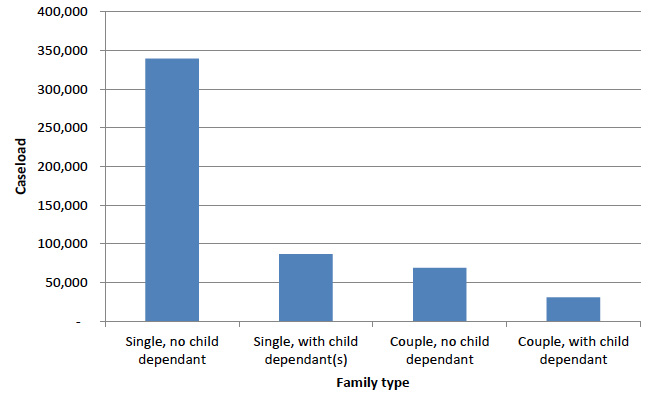
1. Recipients are as at monthly count date (see Background notes, page 25).
Contact
Email: Esther Laird
There is a problem
Thanks for your feedback